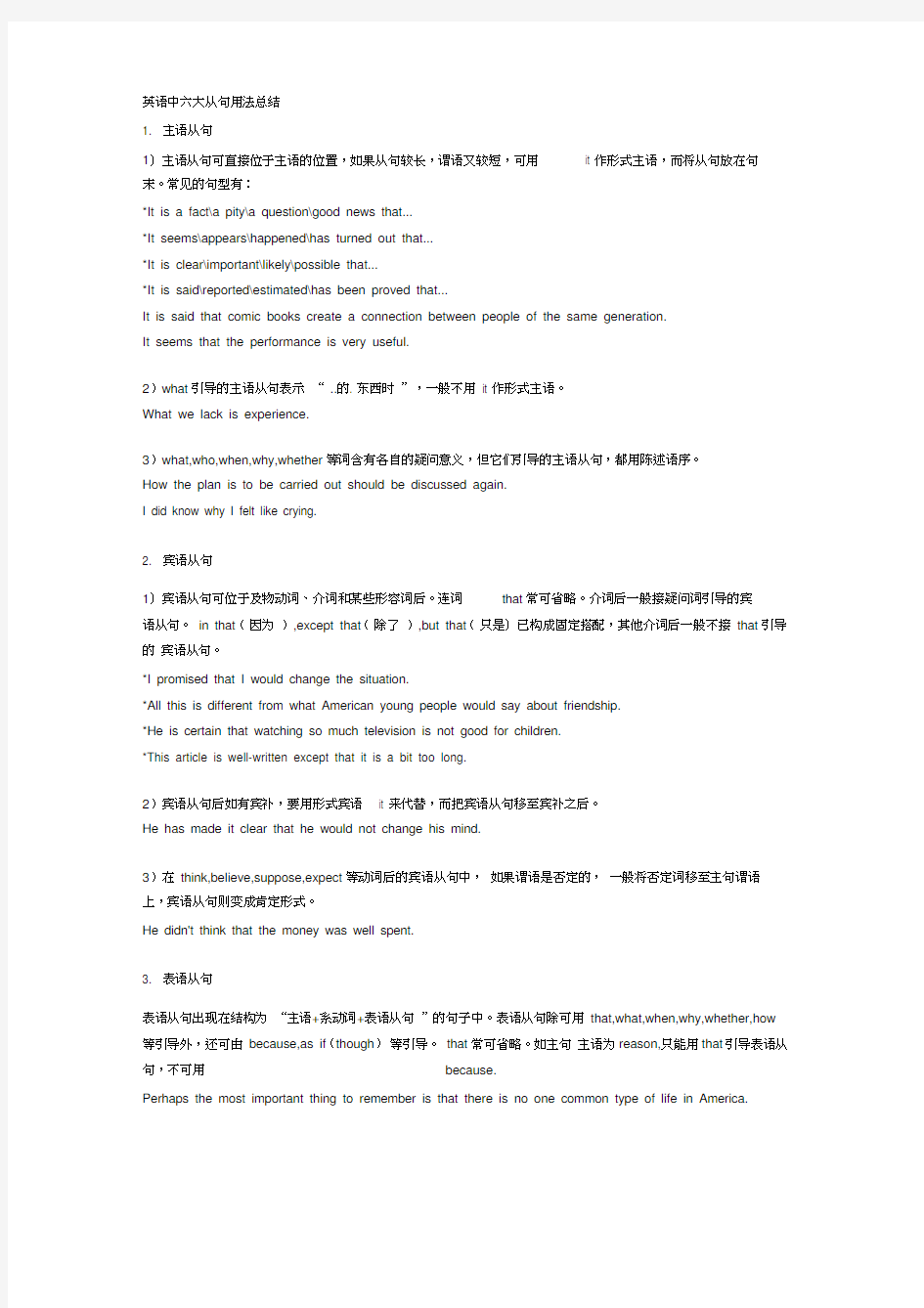英语中六大从句用法总结

- 1、下载文档前请自行甄别文档内容的完整性,平台不提供额外的编辑、内容补充、找答案等附加服务。
- 2、"仅部分预览"的文档,不可在线预览部分如存在完整性等问题,可反馈申请退款(可完整预览的文档不适用该条件!)。
- 3、如文档侵犯您的权益,请联系客服反馈,我们会尽快为您处理(人工客服工作时间:9:00-18:30)。
英语中六大从句用法总结
1. 主语从句
1)主语从句可直接位于主语的位置,如果从句较长,谓语又较短,可用it 作形式主语,而将从句放在句
末。常见的句型有:
*It is a fact\a pity\a question\good news that...
*It seems\appears\happened\has turned out that...
*It is clear\important\likely\possible that...
*It is said\reported\estimated\has been proved that...
It is said that comic books create a connection between people of the same generation.
It seems that the performance is very useful.
2)what 引导的主语从句表示“ ..的. 东西时”,一般不用it 作形式主语。
What we lack is experience.
3)what,who,when,why,whether 等词含有各自的疑问意义,但它们引导的主语从句,都用陈述语序。
How the plan is to be carried out should be discussed again.
I did know why I felt like crying.
2. 宾语从句
1)宾语从句可位于及物动词、介词和某些形容词后。连词that 常可省略。介词后一般接疑问词引导的宾
语从句。in that(因为),except that(除了),but that(只是)已构成固定搭配,其他介词后一般不接that 引导的宾语从句。
*I promised that I would change the situation.
*All this is different from what American young people would say about friendship.
*He is certain that watching so much television is not good for children.
*This article is well-written except that it is a bit too long.
2)宾语从句后如有宾补,要用形式宾语it 来代替,而把宾语从句移至宾补之后。
He has made it clear that he would not change his mind.
3)在think,believe,suppose,expect 等动词后的宾语从句中,如果谓语是否定的,一般将否定词移至主句谓语
上,宾语从句则变成肯定形式。
He didn't think that the money was well spent.
3. 表语从句
表语从句出现在结构为“主语+系动词+表语从句”的句子中。表语从句除可用that,what,when,why,whether,how 等引导外,还可由because,as if(though)等引导。that 常可省略。如主句主语为reason,只能用that引导表语从句,不可用because.
Perhaps the most important thing to remember is that there is no one common type of life in America.
The reason why so many people died there is that there were not enough food supplies.
It looks as if successful international cultural communication will make the world smaller.
4. 同位语从句同位语从句用于对前面出现的名词作进一步说明,一般用连词that 引导,由于先行名词的意义不同,也可用whether,who,when,where,what,why,how 等引导。常见的先行名词有
fact,idea,belief,news,hope,conclusion,evidence,suggestion,order,problem,report,decision. 有时由于谓语较短,将同位语从句位于谓语之后。
She finally made the decision that she would join the fashion show.
I had no idea how many books I could borrow at a time.
The news came that their team had won the championship.
5. 定语从句定语从句所修饰的先行词可以是名词或代词,也可以是一个句子。定语从句通常位于先行词之后,由关系代词或关系副词引导。
*限制性定语从句限制性定语从句修饰先行词,对先行词起修饰作用,紧接先行词之后,无逗号,若省去,原句意思不完整。引导定语从句的关系代词有who,whom,whose,which,that 等。who,whom,whose 用于指人,whose 有时也可指物,相当于of which ;which 用于指物;that 既可指人也可指物,但只用于限制性定语从句中。关系代词除了引导定语从句,替代先行词外,还在从句中担任主语、宾语、定语等。
The computers and cables which make up the Internet are owned by people and organizations.
Those who live alone or who are sick may have trouble in getting close to other people.
The girl whose parents died in an accident is living with her grandmother.
1)当先行词是all,anything,everything,something,nothing 等不定代词或先行词前有
first,last,any,few,much,some,no,only 以及形容词最高级修饰时,只能用关系代词that 引导从句。
That is all that I've heard from him.
He's the first person that I'm going to interview this afternoon.
2)关系代词的省略
在从句中作宾语的关系代词常可省略。关系代词紧跟介词,作介词宾语时不可用that,只可用which或whom 引导从句,并且不可省略,但当介词位于宾语从句句末时,作为介词宾语的关系代词仍可用that,也可省略。
This is one of those things with which we have to put up.
This is one of those things (which\that) we have to put up with.
3) 引导定语从句的关系副词有when,where,why 等。关系副词在从句中作状语,意义上相当于一个“介词
